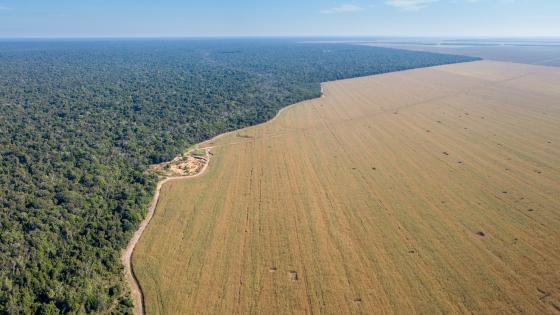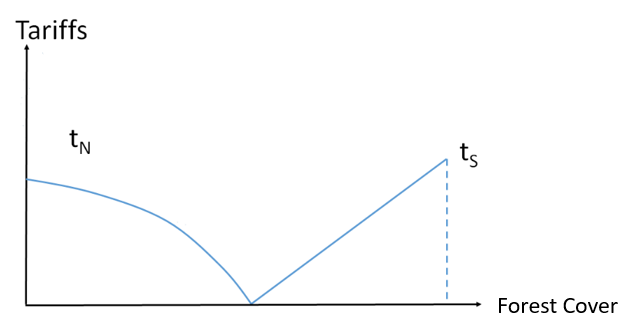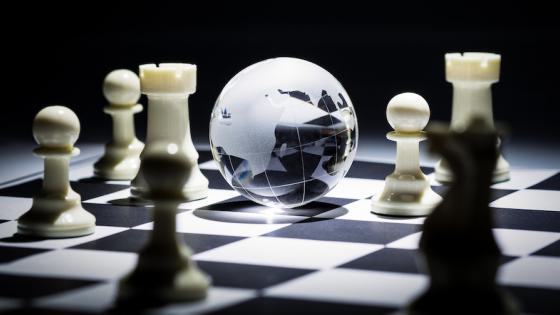EU and Mercosur negotiators are currently pushing to end two decades of trade talks. During these negotiations, which both parties likely thought would end in 2019, the final text has proved challenging to ratify. Several countries in Europe have expressed concerns about deforestation in the Amazon, and the possibility that trade liberalisation will worsen the problem.
The details of the deal will be important. If the parties settle on some kind of ‘additional instruments’ relating to deforestation, they might establish a precedent for future agreements that other countries, such as the US, will sign with Mercosur.
Traditional treaties: From trees to trade
Traditional free trade agreements can lead to deforestation in the tropics. Empirically, deforestation levels do tend to peak when, and after, regional trade agreements have been signed (Abman and Lundberg 2020). The mechanisms driving this fact have been described by several scholars, and they have been recently summarised in a simple dynamic model (Harstad 2024).
Suppose the game is between two parties: the North and the South. The South can be Mercosur and the North can be the EU. (Next time the model is applied, the North might represent the US.) Trade liberalisation expands the market for the South’s beef and other agricultural products, so the profit from a larger agricultural area increases. Anticipating this, the North signs a trade agreement with the South only if the damage from deforestation is low, or if the remaining rainforest cover is already diminished. In other words, not only does free trade cause deforestation, but deforested land raises the gains from trade (and the amount of beef that can be exported). Even before a trade deal is signed, the South can benefit from deforestation because that can, down the road, induce the North to agree on trade liberalisation.
To mitigate the conflicts between trade and environmental problems, traditional remedies include trade sanctions (Barrett 1997), border tax adjustments (Ludema and Wooton 1994), and climate clubs (Nordhaus 2015). Copeland et al. (2022) explain, however, that the traditional solutions are neither efficient, nor credible if the resource is depletable: after depletion, everyone will benefit from trade!
Contingent trade agreements
There are multiple ways of splitting the gains from trade between trading partners. If the North introduces a tariff on beef, for example, the South must reduce the price, in order to export. This reduction means that the North benefits, and the South is harmed, because of the tariff.
The many alternative ways of splitting the overall gains from trade constitute what economists call a ‘Pareto frontier’. Every agreement that leads to a point on this frontier is ‘renegotiation proof’, in the sense that there is no other set of tariffs that is better for both parties. If the South’s value from trade increases when deforestation and land-use change expand the total gains from trading beef, then trade leads to deforestation (Figure 1, left panel, illustrates this.)
With a contingent trade agreement, preliminary tariffs are contingent on the forest cover. They are ‘preliminary’ in the sense that it is not necessary to require that the parties tie their hands to these particular tariff functions. For the tariffs to be credible, therefore, the allocation of the gains from trade must lay on the Pareto frontier.
Importantly, a contingent trade agreement does not require a very different contractual environment. It is sufficient that forest cover, measured by satellites, is verifiable. For Brazil, this is the case, indeed.
The North and the South will both be better off by signing a contingent trade agreement. If the forest is socially valuable to conserve, they will agree on a treaty that allocates more of the gains from trade to the South when the forest cover is large, and less when the forest cover is small. (see Figure 1, right panel.)
Figure 1
Note: Deforestation expands the Pareto frontier because more beef can be traded. With traditional trade agreements, the value for the South (VS) also increases, as in the left panel, and this motivates the South to log. In the right panel, the South obtains the largest gains from trade before the Pareto frontier expands, i.e., as long as there is less deforestation.
Conservation succeeds if the South obtains the largest gains from trade as long as deforestation levels are small (or zero).
To achieve this, tariffs on beef must be high if the forest cover is small, but low if the forest cover is large. If the forest cover is very large, they could even agree that the South is permitted to impose some tariffs on exports from the North, as in Figure 2.
Figure 2 The South conserves if the North sets a low tariff (tN), while the South can set a higher tariff (tS), when the forest cover is large
With this type of agreement, the South will benefit from conserving the forest since conservation is necessary for the South to maintain its favourite terms of trade. The North benefits because more of the forest is conserved. The South benefits also because the North is willing to allocate more of the gains from trade to the South in return for such a conservation-friendly treaty.
Generalisation and calibration
To outline the above reasoning in a pedagogical way – simple enough to be taught to economics students at every level – I rely on a very simple model in Harstad (2024). In a companion paper (Harstad 2023), I allow for a more general international trade model that can incorporate many countries and many goods - this model can also be easily calibrated.
The calibrated analysis suggests that contingent trade agreements can be very beneficial. If the EU (one of six major trading blocs) liberalises trade with Mercosur, the agricultural land area within Mercosur will increase by 5%, which would require deforestation. With a contingent trade agreement, however, the increase can be avoided.
In another scenario, I allow demand by the Asian blocs to double, and liberalise trade with the entire world. This hypothetical scenario would lead to the area of agricultural land within Brazil increasing by 27%, which would require a significant level of deforestation. The increase in this case could be limited to 14% if the EU offers a contingent trade agreement. If both the EU and the US offer a contingent trade agreement, the increase can be limited to 3%, according to the calibration in Harstad (2023).
Modifying the current trade deal between the EU and Mercosur
The EU and the Mercosur bloc have already specified tariff reductions in great detail. For example, the EU tariffs on beef and agricultural products are to be reduced linearly over ten years, starting from their current levels. That is, the tariffs are contingent on the number of years since the treaty is ratified.
This existing contingency in the proposed deal implies that it would be relatively straightforward, on paper, to let tariffs be contingent on forest cover – or changes in the forest cover.
The simplest way to do this would be to allow the EU to restart the ten-year transition period if deforestation levels increase relative to today’s level.
A slightly more sophisticated solution could be to let the EU move the transition clock back by one year for every x units of additional deforestation in a given year.
Here, x must be small enough so that conservation is beneficial for Mercosur. When it is, the contingency is highly beneficial for the EU, because of reduced deforestation.
The contingency will also be beneficial for Mercosur. One reason for this is that when the EU benefits, the EU will be willing to reduce the tariffs faster and further, as long as deforestation levels are small.
Another reason for why the contingency is beneficial for a government in Brazil, say, is that it will help the current government to influence what subsequent governments will do. Even though the current administration by President Lula is conservation friendly, it can only hope that future governments in Brazil will share this willingness to conserve the Amazon forest. With a contingent trade agreement, future governments will be incentivised to continue with forest conservation – whether or not they share the political viewpoints of the current government.
Editors' note: This column also appeared on VoxDev.
References
Abman, R, and C Lundberg (2020), "Does Free Trade Increase Deforestation? The Effects of Regional Trade Agreements," Journal of the Association of Environmental and Resource Economists 7(1): 35-72.
Barrett, S (1997), "The Strategy of Trade Sanctions in International Environmental Agreements," Resource and Energy Economics 19(4): 345-61.
Copeland, B R, J S Shapiro and S M Taylor (2022), "Globalization and the environment," in G Gopinath, E Helpman, and K Rogoff (eds.), Handbook of International Economics 5: 61-146. Elsevier.
Harstad, B (2023), "Contingent Trade Agreements." Mimeo, Stanford University.
Harstad, B (2024), "Trade and Trees", American Economic Review: Insights (forthcoming).
Ludema, R D, and I Wooton (1994), "Cross-Border Externalities and Trade Liberalization: The Strategic Control of Pollution," Canadian Journal of Economics 27(4): 950-66.
Nordhaus, W (2015) "Climate clubs: Overcoming free-riding in international climate policy," American Economic Review 105(4): 1339-70.





